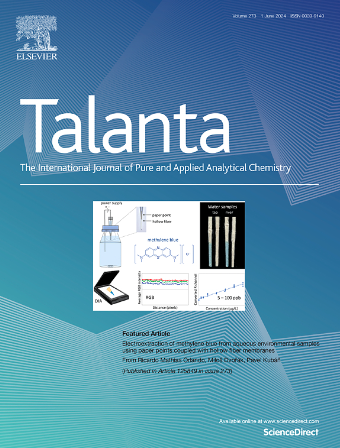用于非酶法葡萄糖检测的微加工钛/镍电极:模拟血液条件下的机理认识和干扰分析
IF 5.6
1区 化学
Q1 CHEMISTRY, ANALYTICAL
引用次数: 0
摘要
本文章由计算机程序翻译,如有差异,请以英文原文为准。

Microfabricated Ti/Ni electrodes for non-enzymatic glucose detection: Mechanistic insights and interference analysis in blood-mimicking conditions
Accurate glucose monitoring is essential for diabetes management, and while enzymatic sensors dominate the market, their limitations in stability and reliability under extreme conditions require alternative approaches. This study presents a non-enzymatic glucose sensor based on Ti/Ni electrodes fabricated via microfabrication techniques, designed to operate across a broad glucose concentration range (0–30 mM) and under physiological conditions. Electrochemical evaluations using cyclic voltammetry and chronoamperometry confirm the catalytic oxidation of glucose on Ni surfaces, demonstrating high sensitivity and selectivity. The sensor achieves a LoD of 1.29 mM, a LoQ of 3.93 mM, in alkaline solution. Interference analysis with common blood analytes such as uric acid, acetaminophen, and ascorbic acid, reveals that Ti/Ni electrodes outperform copper-based alternatives in minimizing cross-reactivity, meeting ISO 15197 standards for selectivity. Integrating NaOH-modified cellulose fibers for pH stabilization further supports the sensor's adaptability for in situ applications. These findings underscore the potential of Ti/Ni electrodes to enhance the development of stable, reliable, and non-enzymatic glucose sensors for clinical and wearable technologies.
求助全文
通过发布文献求助,成功后即可免费获取论文全文。
去求助
来源期刊

Talanta
化学-分析化学
CiteScore
12.30
自引率
4.90%
发文量
861
审稿时长
29 days
期刊介绍:
Talanta provides a forum for the publication of original research papers, short communications, and critical reviews in all branches of pure and applied analytical chemistry. Papers are evaluated based on established guidelines, including the fundamental nature of the study, scientific novelty, substantial improvement or advantage over existing technology or methods, and demonstrated analytical applicability. Original research papers on fundamental studies, and on novel sensor and instrumentation developments, are encouraged. Novel or improved applications in areas such as clinical and biological chemistry, environmental analysis, geochemistry, materials science and engineering, and analytical platforms for omics development are welcome.
Analytical performance of methods should be determined, including interference and matrix effects, and methods should be validated by comparison with a standard method, or analysis of a certified reference material. Simple spiking recoveries may not be sufficient. The developed method should especially comprise information on selectivity, sensitivity, detection limits, accuracy, and reliability. However, applying official validation or robustness studies to a routine method or technique does not necessarily constitute novelty. Proper statistical treatment of the data should be provided. Relevant literature should be cited, including related publications by the authors, and authors should discuss how their proposed methodology compares with previously reported methods.
 求助内容:
求助内容: 应助结果提醒方式:
应助结果提醒方式:


